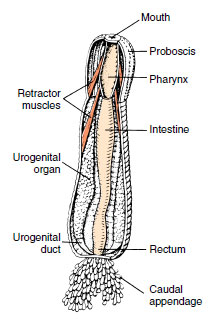Phylum Priapulida
Phylum Priapulida
Priapulida (pri´a-pyu´li-da) (Gr. priapos, phallus, + ida, pl. suffix) are a small group (only 18 species) of marine worms found chiefly in colder waters of both hemispheres. They have been reported along the Atlantic coast from Massachusetts to Greenland and along the Pacific coast from California to Alaska. They live in mud and sand of the sea floor and range from intertidal zones to depths of several thousand meters. Tubiluchus (L. tubulus, dim. of tubus, waterpipe) is a minute detritus feeder adapted to interstitial life in warm coralline sediments. Maccabeus (named for a Judean patriot who died in 160 B.C.) is a tiny tube-dweller discovered in muddy Mediterranean bottoms.
Form and Function
Priapulids have cylindrical bodies, usually
less than 12 to 15 cm long, but Halicryptus higginsi is up to 39 cm in
length. Most of them are burrowing
predaceous animals that usually orient
themselves upright in the mud with the
mouth at the surface. They are adapted
for burrowing by body contractions.
The body includes a proboscis, trunk, and usually one or two caudal appendages (Figure 15-9). Their eversible proboscis is ornamented with papillae and ends with rows of curved spines that surround their mouth. The proboscis is used in sampling the surroundings as well as for capturing small, soft-bodied prey. Maccabeus has a crown of brachial tentacles around its mouth.
The trunk is not metameric but is superficially divided into 30 to 100 rings and is covered with tubercles and spines. The tubercles are probably sensory in function. The anus and urogenital pores are located at the posterior end of the trunk. The caudal appendages are hollow stems believed to be respiratory and probably chemoreceptive in function. A chitinous cuticle, molted periodically throughout life, covers the body.
The digestive system contains a muscular pharynx and a straight intestine and rectum (Figure 15-9). There is a nerve ring around the pharynx and a midventral nerve cord. The body cavity contains amebocytes and, at least in Priapulus caudatus, corpuscles containing a respiratory pigment called hemerythrin.
Sexes are separate. The paired urogenital organs are each made up of a gonad and clusters of solenocytes, both connected to a protonephridial tubule that carries both gametes and excretory products to the outside. Embryology is poorly known. In some the egg undergoes radial cleavage and develops into a stereogastrula. Larvae of Priapulus dig into the mud and become detritus feeders.
Long considered pseudocoelomate, priapulids were erroneously judged coelomate when nuclei were found in membranes lining the body cavity, the membranes thus interpreted as a peritoneum. However, electron microscopy showed that nuclei of their muscle cells were peripheral, and the muscles secreted an extracellular membrane. The muscle nuclei and extracellular membrane gave the false appearance of an epithelial lining.
Priapulida (pri´a-pyu´li-da) (Gr. priapos, phallus, + ida, pl. suffix) are a small group (only 18 species) of marine worms found chiefly in colder waters of both hemispheres. They have been reported along the Atlantic coast from Massachusetts to Greenland and along the Pacific coast from California to Alaska. They live in mud and sand of the sea floor and range from intertidal zones to depths of several thousand meters. Tubiluchus (L. tubulus, dim. of tubus, waterpipe) is a minute detritus feeder adapted to interstitial life in warm coralline sediments. Maccabeus (named for a Judean patriot who died in 160 B.C.) is a tiny tube-dweller discovered in muddy Mediterranean bottoms.
Form and Function
 |
| Figure 15-9 Major internal structures of Priapulus. |
The body includes a proboscis, trunk, and usually one or two caudal appendages (Figure 15-9). Their eversible proboscis is ornamented with papillae and ends with rows of curved spines that surround their mouth. The proboscis is used in sampling the surroundings as well as for capturing small, soft-bodied prey. Maccabeus has a crown of brachial tentacles around its mouth.
The trunk is not metameric but is superficially divided into 30 to 100 rings and is covered with tubercles and spines. The tubercles are probably sensory in function. The anus and urogenital pores are located at the posterior end of the trunk. The caudal appendages are hollow stems believed to be respiratory and probably chemoreceptive in function. A chitinous cuticle, molted periodically throughout life, covers the body.
The digestive system contains a muscular pharynx and a straight intestine and rectum (Figure 15-9). There is a nerve ring around the pharynx and a midventral nerve cord. The body cavity contains amebocytes and, at least in Priapulus caudatus, corpuscles containing a respiratory pigment called hemerythrin.
Sexes are separate. The paired urogenital organs are each made up of a gonad and clusters of solenocytes, both connected to a protonephridial tubule that carries both gametes and excretory products to the outside. Embryology is poorly known. In some the egg undergoes radial cleavage and develops into a stereogastrula. Larvae of Priapulus dig into the mud and become detritus feeders.
Long considered pseudocoelomate, priapulids were erroneously judged coelomate when nuclei were found in membranes lining the body cavity, the membranes thus interpreted as a peritoneum. However, electron microscopy showed that nuclei of their muscle cells were peripheral, and the muscles secreted an extracellular membrane. The muscle nuclei and extracellular membrane gave the false appearance of an epithelial lining.




